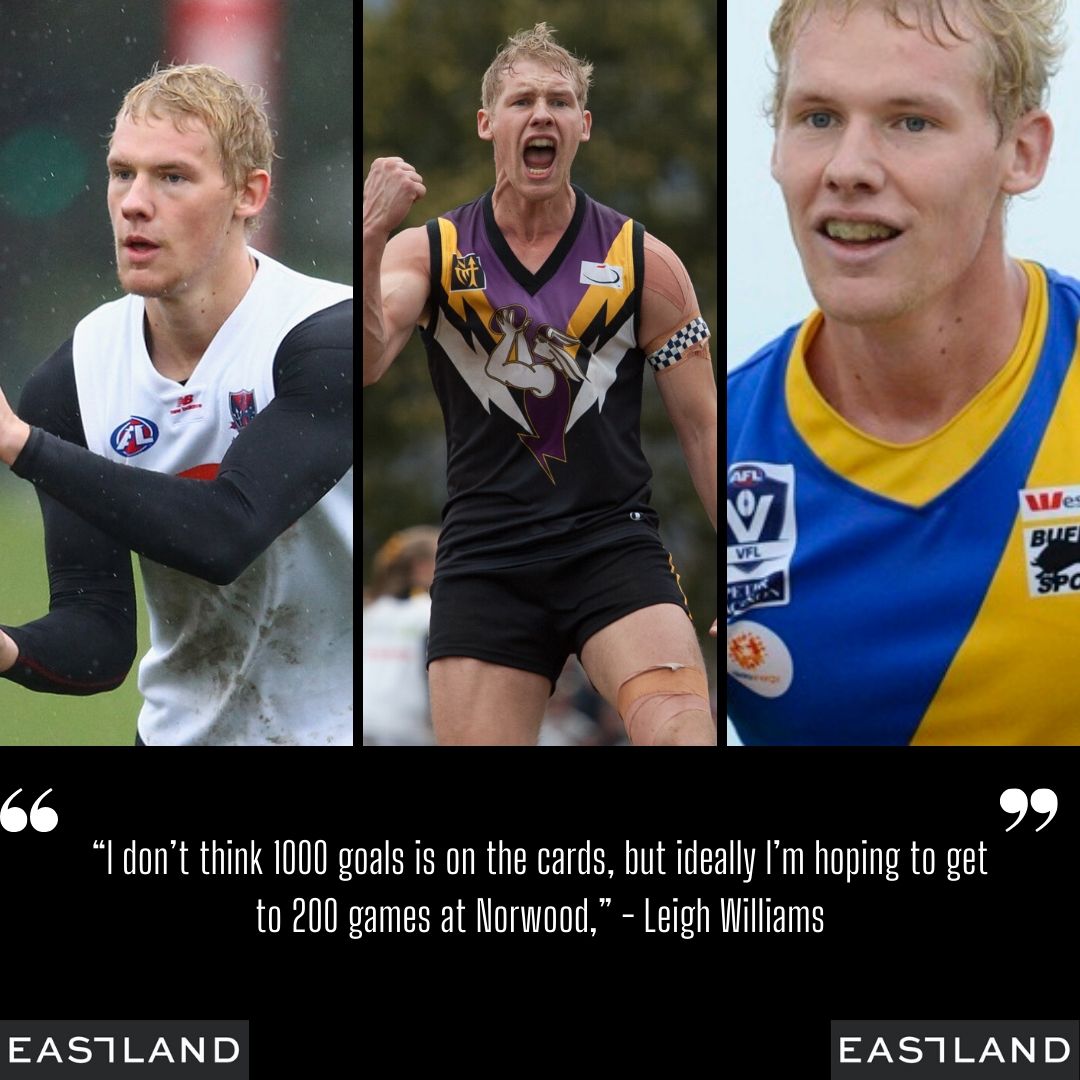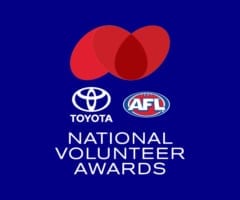By Matt Fotia
Leigh Williams has been one of the defining EFNL forwards of the last decade, if not the defining forward, tearing apart defences for both his beloved Norsemen as well as the league itself. But it hasn’t all been smooth sailing for the blonde bombshell, with consistent injury battles curtailing what could’ve been an even more impressive career.
The current Norwood spearhead crossed over to the club as junior, having previously played his football at Park Orchards who were then just a junior club.
Relationships with Norwood players such as Dean Poynton, combined with living on the same road as the Wooders home ground, helped make the decision to move inevitable.
Always a talented player, Williams found himself at Eastern Ranges as a 16-year-old, describing himself as a lightly built utility, having spent time at Centre Half Back, in the Ruck and on the Wing as a junior.
A knee injury in his bottom age year saw him culled from the Ranges program despite the fact he’d debuted for Norwood’s senior side in 2007 aged just 17.
His first game saw him take on Lilydale in a Division One clash, with the skinny debutant starting in the back pocket as the Falcons ran out 41 point winners.
The now 29-year-old can’t remember too much from his debut season but can recall that the men in Purple weren’t quite the force they would become.
“I think I played back pocket in that first game, but I’d played a couple of the practice games in the pre-season, so the actual debut wasn’t as daunting as I thought it might be,”
“But to be honest I can’t remember too much about the first few games, we weren’t much chop back in those days,” said Williams.
Williams continued to play mainly as a defender, playing a full season in 2009 as Norwood finished eighth.
It was in 2010 the he first started making waves in the competition, booting 67 goals in 20 games – including eight against East Burwood – as Norwood reached the semi-finals.
The catalyst for both his and the club’s upturn – a new inclusion to the side.
“Stuart Hill had just come down to the club and him slotting into the backline meant I was swung forward,”
“Even then I was only moved to full forward because I was getting bags kicked on me at full back.”
His time in defence had given him a good understanding of what made a successful key forward.
“I was pretty skinny still and once I worked out that I was going to be playing in the forward line regularly, I knew I had to get bigger, so I put on around eight or nine kilograms knowing that’s what was required for my new role,”
“I was getting bullied by some of the better key defenders at the time like Jimmy Grant from Croydon and thought if I could get a little bit bigger it would make things a bit easier on that front.”

Williams doesn’t get bullied anymore – Davis Harrigan Photography
The weight gain certainly worked. In 2011 Williams topped the EFL’s Goal Kicking tables with 88 goals in the home and away season – a total no one has bettered since – despite Norwood finishing seventh.
His haul included nine games with five goals or more, with a bag of 14 against Mulgrave the jewel in the crown.
It could’ve been more with Williams kicking seven behinds that day by all reports.
Williams dominance in 2011 drew attention from people in higher places, and at the age of 21 – just a few years after being cut by Eastern Ranges – Leigh Williams found himself on an AFL List, taken by Melbourne with pick 59 in the Rookie Draft.
It was an interesting time to be at the Demons, with Mark Neeld having just taken the job following the departure of Dean Bailey in 2011.
Neeld’s tenure, which saw the Demons win five games from a possible 33, has been heavily criticised since, with a number of senior players finding fault in his approach.
But Williams, a kid plucked from local football, enjoyed his one year on an AFL list.
“I didn’t think I was going to get drafted at the age of 21 out of local footy, but a Melbourne recruiter got a hold of me out of the blue and I was on their list,”
“The experience itself was pretty good for me, it was Mark Neeld’s first year at Melbourne and there’s a lot of criticism from some of the older blokes there at the time, but for me personally, coming from local footy, I didn’t see what those elite players were seeing,”
“I had a really good experience with him and the club that year.”
Williams managed Nine games for Casey in the VFL returning 14 goals, with a series of injuries – including being placed in an induced coma – bringing his time at the elite level to a close.
He’s taken plenty from his fleeting time at the club but does wish he could’ve had a red hot go at it.
“It wasn’t great in terms of playing time, but I learnt a lot about my body and what it takes to be at that next level,”
“But I probably didn’t really get the opportunity I would’ve liked and it’s a bit more annoying that it wasn’t really in my control, I got there, got a lot of injuries and then it was over.”
He didn’t completely give up on the dream, choosing to align with VFL club Williamstown in 2013, but once again injuries stood in his way, with torn ligaments in his foot meaning he could play just four games for the Seagulls.
He did manage to squeeze in seven games – booting 21 goals – for Norwood though, as they reached the semi-final once again. He then decided that he’s going to be a Norwood player only from then on, a fairly good time to commit whole heartedly to the club.
2014 is, to date, probably the greatest year in the club’s history.
The Wooders took all before them on their way to the 2014 Division One premiership, losing just two games for the whole season.
They made Balwyn look second rate in the decider as well, running out 51-point winners, 14.16(100) to 7.7(49).
Williams started the season like a man possessed, kicking 44 goals in the first eight games of the year, including nine against Lilydale, before injuring the ligaments in his foot again.
“I think those first eight to nine games were my best ever and then I re-injured the ligaments in my foot again and thought that was my season over.”
He returned for the last two rounds of the home and away season and hit the ground running, managing a further 18 goals, including six on Grand Final to win the Cliff Tomkins Medal for best on ground.
Whilst 2015 – where he kicked 79 goals in 21 games – is a better year on a personal level for pure durability terms, Williams will never forget 2014.
“2014 is the best list that Norwood has ever assembled, I think we only lost two games for the entire season and they were by both by under two goals,”
“2015 was better overall personally because I was able to get through injury free, but the memories from 2014 won’t be matched.”
The Cliff Tomkins Medal was a sign of things to come as well, with Williams making a habit of stepping up on a big occasion.
The powerful goal kicker has a sterling representative record, having been best on ground in the EFNL’s two most recent Interleague clashes, including seven goals to claim the number one ranking from AFL Barwon, as well as a seven-goal bag for Vic Metro against Queensland in 2015, despite some less than desirable preparation.
“That day we were pretty disappointed because we flew up on the Friday for the game on Saturday, but we were told we were going to fly home Saturday night, so the boys decided to make the most of it on the Friday – It was good fun.”
Williams attributes his incredible Interleague form to the skill level of his teammates, citing their football smarts as the main reason behind his impressive hauls on route to claiming the number one mantle for the league.
“Being able to play with the elite players from other teams like Parker, Schneider, Best and co, you have this like mindedness and you know the Footy IQ is there and as a forward it makes it so much easier, because you are relying on the guys are further up the ground, knowing where they’re going to put the footy and that’s a big thing.”
“There were a few guys who had played in the carnivals for a number of years in a row and had been a part of the journey and that was the pleasing thing – the level of accomplishment we all got from the ride.”
Unfortunately, it’s been a different story at club level for Williams.
Norwood have been unable to reach the finals since 2015 – where Balwyn claimed revenge winning the Grand Final by 111 points– but Williams is confident that they’re on the right track under new coach Marty Pask.
“Being a younger coach, he’s got a bit of the new generation thing going – he’s closer to being one of the lads then he is one of the dads,”
“He’s bringing in the right sort of culture, especially outside of just playing, he makes that effort to get the community aspect right which is key at community footy level.”
On a personal note it’s games played, not goals kicked that will drive Williams for years to come, despite a few punters speculating that he could reach the 1000 goal barrier.
“I don’t think 1000 goals is on the cards, but ideally I’m hoping to get to 200 games at Norwood,”
“That’s always been a goal of mine and I’m the aerobically the fittest I’ve ever been, so who knows.”

How many more Leigh William’s fist pumps will we see?
Leigh Williams Career Stats & Accolades
| Year | Games | Goals |
| 2007 | 3 | 1 |
| 2009 | 18 | 16 |
| 2010 | 20 | 67 |
| 2011 | 18 | 88 |
| 2013 | 7 | 21 |
| 2014 | 12 | 62 |
| 2015 | 21 | 79 |
| 2016 | 14 | 66 |
| 2017 | 17 | 70 |
| 2018 | 18 | 72 |
| 2019 | 19 | 58 |
| Overall | 161 | 600 (3.73 average goals per game) |
4 x EFNL Division One League Goal Kicking Medal
6 x Division One/Premier Team of the Year
1 x Cliff Tomkins Medal
2014 Division One Premiership
EFNL Interleague Player










































